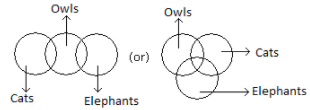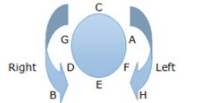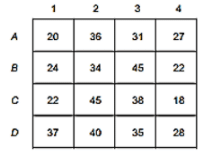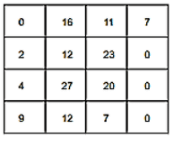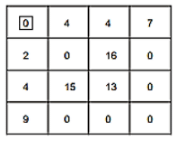Practice Test: Mechanical Engineering (ME)- 13 - Mechanical Engineering MCQ
30 Questions MCQ Test - Practice Test: Mechanical Engineering (ME)- 13
A 300-meter-long train passes a 450-meter-long platform in 5 sec. If a man is walking at a speed of 4 m/sec along the track and the train is 100 m away from him, how much time will it take to reach the man?
A boat takes half the time moving a certain distance downstream than upstream. The ratio of the speed of the boat to that of the current is
| 1 Crore+ students have signed up on EduRev. Have you? Download the App |
Which of the following words is opposite to the word “connivance”?
Direction: A number is wrong in the following number series. Select the wrong number.
64, 130, 264, 536, 1076
Direction: Each statement has a blank followed by four options. Select the most appropriate word for the blank. Guru was always able to maintain a _______ face when he said something silly, and that contrast made everyone laugh.
A supermarket launched a scheme that if a customer purchases two CDs, one extra CD will be free and if he purchases 3 Mobiles he will get one extra Mobile free. If the cost price of 3 CD and 4 Mobile be Rs.6700 and Rs.232500 respectively. If a customer purchase 2 CD and 3 Mobile as per scheme he availed 1 product free of each category, then at what price these product should be sold so that the agency can get overall profit of 17.5%
In the following question, two/three statements are given followed by four conclusions. You have to consider the statements to be true even if they seem to be at variance from commonly known facts. You have to decide which of the given conclusions, if any, follow from the given statements.
Statements:
I. Some cats are owls.
II. Some owls are elephant.
Conclusion:
I. Some cats are elephant.
II. All owls are elephant.
In the following question, a set of labelled sentences is given. Out of the four alternatives, select the most logical order of the sentences to form a coherent paragraph.
(P) The over 11-km Mundka-Bahadurgarh section of Delhi Metro’s Green Line, connecting the capital of Haryana, was inaugurated by the Prime Minister.
(Q) The rapidly growing industry in the area was waiting for Metro connectivity, said Mr.PM, adding that it would create new employment opportunities and benefit students.
(R) Built at a cost of Rs 2,028 crore, the Mundka-Bahadurgarh elevated section, with seven stations, is the third Metro extension between Delhi and Haryana.
S)Mr. Prime Minister said Bahadurgarh was known as the Gateway of Haryana and would now be the Gateway of Development with the advent of the Metro.
Study the information given below and answer the questions based on it.
Eight friends, A, B, C, D, E, F, G and H are sitting around a circle (not necessarily in the same order) facing the centre. B sits third to the left of F. E is an immediate neighbour of both B and H. Only one person sits between A and H. C and G are immediate neighbours of each other. Neither C nor G is an immediate neighbour of B. Only one person sits between C and D.
Who amongst the following is an immediate neighbour of both A and H?
Direction: Study the line graph carefully and answer the given questions.
The graph shows the total number of students who attended the exams and the total number of students who passed the exam in different years of school.
Note:
1. The total number of students enrolled in each year= The total number of students who appeared in the exam + The total number of students who didn’t appear in the exam
2. The total number of students who appeared in the exam= The total number of students passed in the exam + The total number of students who failed in the exam
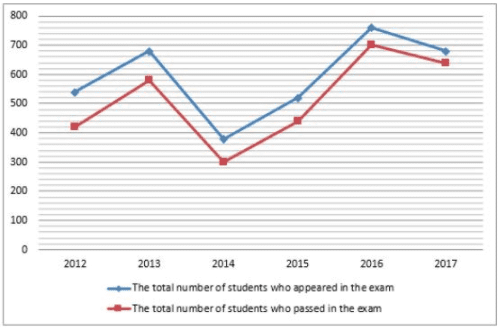
What is the average number of students who failed over the years?
Determine the variation in tractive effort if the driving wheel diameter is 2m of a two cylinder locomotive. Consider the following parameters
Mass of reciprocating parts per cylinder = 300 kg
Distance between cylinder centre lines = 0.55 m
Crank radius = 0.2 m
Cranks are at angles = 90°
If the velocity of hammer blow is 80km/h and take c = 0.75
In a heat exchanger, the hot liquid enters with a temperature of 200°C and leaves at 180°C. The cooling fluid enters at 50°C and leaves at 130°C. The capacity ratio of the heat exchanger is __________.
Consider a signal x (t) given by ![]() , then x(t) is given by
, then x(t) is given by
A smaller sphere (1) of radius 50 mm is inside a larger sphere (2) of radius 100 mm. What will be the value of the radiation shape factor F22:
A cast steel slab of dimension 40×20×10 cm, is poured horizontally using a side riser. The riser is cylindrical in shape with diameter and height both equal to 20 cm. Then the freezing ratio is___.
Determine the magnitude of the moment transferred to the center of the pulley. If a differential pulley of diameters 400 mm and 200mm respectively are used, and is subjected to belt tensions.
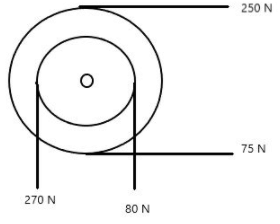
The given eigen values of the following matrix are represented by λ1 and λ2
A =  The value of λ12 + λ22 + λ1λ2 is ___.
The value of λ12 + λ22 + λ1λ2 is ___.
A solid aluminium shaft, 5 cm diameter and 1 m long, is to be replaced by a tubular steel shaft of the same length and the same outside diameter (i.e. 5 cm), such that each of the two shaft could have the same angle of twist per unit torsional moment over the total length. Modulus of rigidity of steel is three times that of aluminium. The inner diameter of the tubular shaft is
Threaded Bolts B1 and B2 of similar length and material are subjected to similar tensile load. If the elastic strain energy stored in bolt B1 is 4 times as compared to bolt B2, then what will be the mean diameter of bolt B2. The mean diameter of bolt B1 is 20mm.
Which of the following are correct?
(P) Slenderness ratio is defined as the ratio of the effective length of the column to the minimum radius of the gyration
(Q) Euler’s formula is applicable for short columns
(R) Rankine’s constant for mild steel is 1/7500
A cantilever is subjected to a UDL the cross section of the beam is H-section placed as shown in fig. The bending stress distribution across the cross section will be
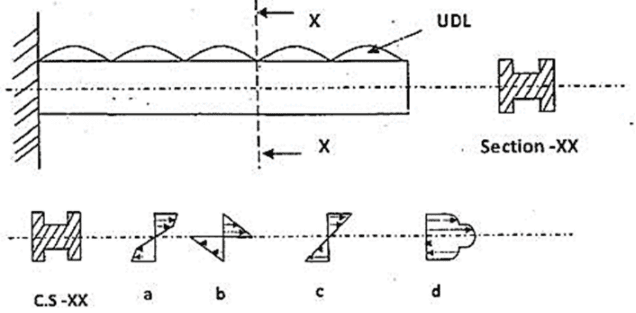
A fluid (Prandtl number, Pr = 1) at 500 K flows over a flat plate of 1.5 m length, maintained at 300 K. The velocity of the fluid is 10 m/s. Assuming kinematic viscosity, ν = 30 × 10 − 6 m2/s, the thermal boundary layer thickness (in mm) at 0.5 m from the leading edge is __________
A slot is to be milled by a side and face milling cutter with 10 teeth and of diameter 150 mm. the cutting speed is 50 m/min and feed is 0.95 mm/tooth. The table feed in mm/min will be
In the gear train of 1 : 10 as shown below, the pinion transmits 250 kW at 1800 rpm. What is the tangential load on the gear tooth?
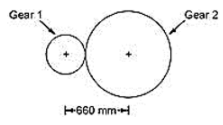
Four technicians are required to do four different jobs. Estimates of time to complete every job provided by the technicians are as below
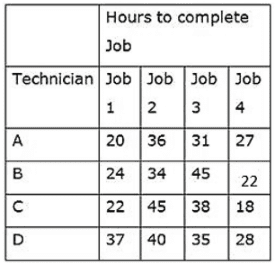
The minimum time to complete all jobs is _______.
An orifice meter consisting of 0.1m diameter orifice in a 0.25m diameter pipe has a coefficient equal to 0.65. The pipe delivers oil of specific gravity 0.8. The pressure difference on the two sides of the orifice plate is measured by the Mercury-Oil differential manometer. If the differential gauge reads 0.8 meter of Mercury, the rate of flow in cubic meters per second is
Oil having density of 800 Kg/m3 and viscosity of 0.2Ns/m2 is flowing through a pipeline of 50mm diameter at an average velocity of 2 m/s. The Darcy friction factor for the flow is
What is directional derivative of ∅ =xy2 + yz3 at P (2, -1,1) in the direction of a normal to the surface x log z - y2 = -4 at A (-1, 2, 1)?
The pressure outside of the water droplet of diameter 0.06mm is 12 N/cm2. Calculate the pressure within the droplet. The surface tension is given as 0.08N/m.
For exchanging notes in a bank 50 customers arrive in 60 min which follows Poisson's distribution and service time follows exponential distribution. Due to lack of notes there is a single window for exchange and serves as a first come first serve basis. Probability of more than 20 customers in the system is 0.3 then, how much mean time is required for exchanging notes for a customer on the counter?


